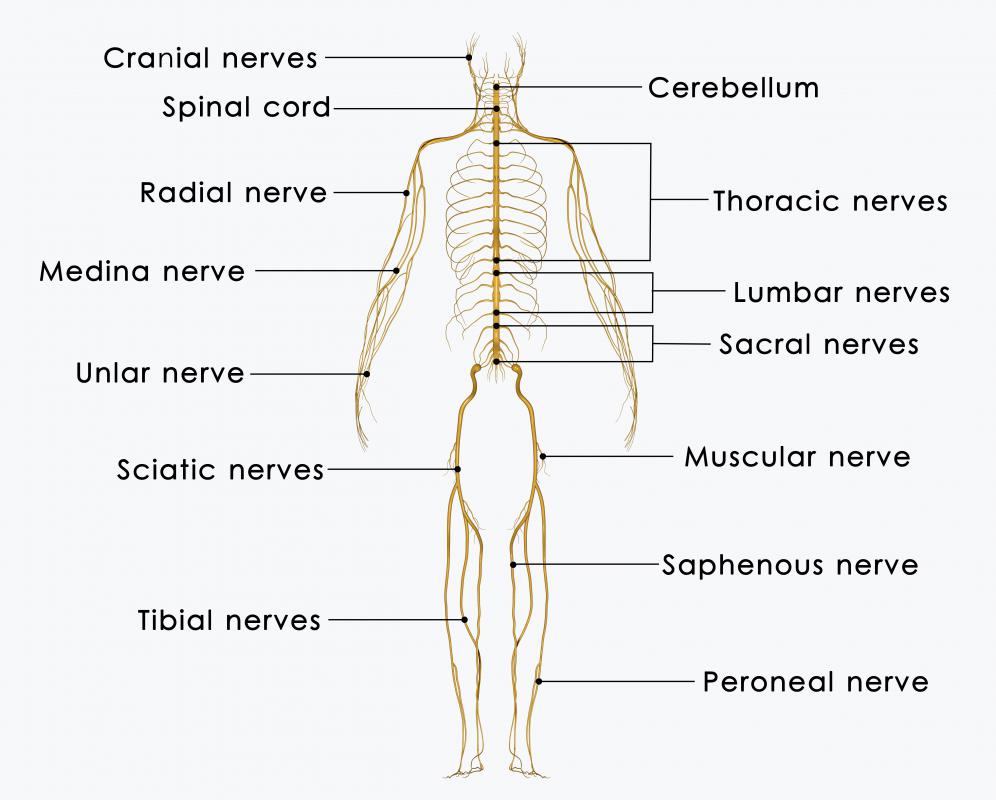At TheHealthBoard, we're committed to delivering accurate, trustworthy information. Our expert-authored content is rigorously fact-checked and sourced from credible authorities. Discover how we uphold the highest standards in providing you with reliable knowledge.
What Is Long Thoracic Nerve Palsy?
Long thoracic nerve palsy is caused by injury and damage to the long thoracic nerve. This nerve runs from the neck vertebrae along the side of the chest to the muscle that holds the scapula bone to the chest wall. When this nerve is damaged, the scapula — or shoulder blade — becomes abnormally positioned, resembling a protruding wing. This odd positioning has led to the name "winged scapula." Shoulder pain and loss of movement occur as the imbalance in muscle functioning causes stress to the muscles of the shoulder.
Injuries to the long thoracic nerve may also involve the brachial plexus nerve. At one point above the collarbone, the two nerves run parallel to each other. If the injury occurs at this position, the brachial plexus — which runs the entire length of the arm, innervating the muscles of the arm and hand — could also be affected. Injuries near the vertebrae of the neck where these nerves originate may also affect both nerves, causing palsy and loss of function in the arm and hand.

There are many possible causes of long thoracic nerve palsy, but most cases are due to direct injury or strenuous repetitive movements. The nerve runs fairly close to the surface and can be easily affected by an impact to the upper body. Sports injuries are a common cause. Activities like weight lifting, where load bearing repetitive movement stresses the nerve, may also cause damage to the nerve. Surgical procedures, such as radical mastectomies, and deep tissue massage might also cause problems.

The long thoracic nerve passes through the middle scalene muscle that attaches the neck vertebrae to the first rib. Medical professionals believe that compression of this muscle may contribute to long thoracic nerve palsy. Contraction of the muscle and resulting nerve damage can occur during exercise. This view is supported by the number of patients who develop this condition and who have a history of strenuous upper body activities. These include weight lifting or lifting and carrying heavy loads.

Diagnosis involves a test of the electrical conductivity of the nerve using the nerve conduction velocity test or similar procedure. Once nerve damage is detected, appropriate treatment is given. Nerve injuries can take a relatively long time to resolve and may only partially heal. Both physical therapy and surgery are used as treatments. Decompression of the nerve or surgical nerve transfer are possible treatment options.
AS FEATURED ON:
AS FEATURED ON:

















Discussion Comments
To Discographer: Parsonage-Turner syndrome is one potential cause of long thoracic nerve palsy, but is normally non-traumatic, in the sense that it is not the direct result of an injury to the LTN. In the case of PTS, the damage to the nerves is (generally recognized to be) mediated by the immune system. PTS will typically pick out a few nerves to damage; it's unusual for it to confine itself to a single nerve. Source: much reading and grim personal experience. I am not a doctor.
Hi ysmina, I also was diagnosed with long thoracic nerve palsy. How are you doing with your physiotherapy sessions?
@ysmina: I too was diagnosed with long thoraic nerve palsy. I went to physical therapy for six months with no results. I ended up having to go see a specialist at Wake Forest Hospital. The surgeon, Dr. Li is awesome. It has been a year and a half since the operation. I still feel pain when I overexert my shoulder and it lasts for a week or so. But other than that, I am pretty much back to normal.
Good luck with yours. I know it is hard and people might think you are making it up or not be so supportive because they don't understand. To me, it was heartbreaking to not be able to lift my arm or do things I normally would and people thought I was exaggerating. I hope that you do not need surgery. Just remember to take it easy.
What's the difference between Parsonage-Turner Syndrome and long thoracic nerve palsy? The symptoms sound the same.
@ysmina-- I had this condition several years ago, thankfully I didn't need surgery. The nerves healed on their own in about six months and of course I did go to physical therapy meanwhile.
Don't be discouraged by what your doctor said. Most of the time, the nerves will fix themselves. The parts that are damaged are able to grow back but you need to follow directions and rest. It can take anywhere from six months to a year to recover naturally.
If you do end up needing surgery, I heard that it's fairly easy and recovery is not difficult either.
I've just been diagnosed with this and have started physiotherapy. My doctor wants to see if I will respond to the therapy for at least the next six months. If not, I might have to have surgery.
Just wondering if anyone else here is suffering from this? If so, what has your treatment been like?
What are the chances that I will show improvement with physiotherapy? Has anyone here had to have surgery due to long thoracic nerve injury?
Post your comments